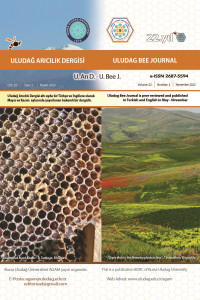Abstract
A cheap, versatile and effective method of hornets’ colony elimination based on the light-provoked contact of flying individuals with the 20-30% solution of NaOH is reported. Importantly, the insects survived from touching with this alkali solution transported the poison to the nest.
References
- Hamkalo M, Romaniv P. The soils of the Carpathian region of Ukraine as objects of scientific tourism. Visnyk of the Lviv University Series Geography. 2017;51: 80–87, doi.org/10.30970/vgg.2017.51.8740
- Mattila, HR, Otis, GW, Nguyen, LTP, Pham, HD, Knight, OM, Phan, NT. Honey bees (Apis cerana) use animal feces as a tool to defend colonies against group attack by giant hornets (Vespa soror). PLoS ONE. 2020;15(12):1-24, doi.org/10.1371/journal.pone.0242668
- Monceau K, Bonnard O, Thiéry D. Vespa velutina: a new invasive predator of honeybees in Europe. J. Pest. Sci. 2014; 87: 1-16, doi.org/10.1007/s10340-013-0537-3
- Monceau K, Thiéry D. The Asian Yellow-legged Hornet: The implacable advance of a bee-killer. British Wildlife. 2017;29(2):79-84.
- Requier F, Rome Q, Villemant C, Henry M. A biodiversity friendly method to mitigate the invasive Asian hornet’s impact on European honey bees. J. Pest. Sci. 2020; 93: 1-9. doi.org/10.1007/s10340-019-01159-9.
Abstract
Uçan bireylerin %20-30 NaOH çözeltisi ile ışıkla uyarılan temasına dayanan eşek arısı kolonilerinin ortadan kaldırılması için ucuz, çok yönlü ve etkili bir yöntem bildirilmektedir. Daha da önemlisi, bu alkali solüsyonla temastan kurtulan böcekler, zehiri yuvaya taşır.
References
- Hamkalo M, Romaniv P. The soils of the Carpathian region of Ukraine as objects of scientific tourism. Visnyk of the Lviv University Series Geography. 2017;51: 80–87, doi.org/10.30970/vgg.2017.51.8740
- Mattila, HR, Otis, GW, Nguyen, LTP, Pham, HD, Knight, OM, Phan, NT. Honey bees (Apis cerana) use animal feces as a tool to defend colonies against group attack by giant hornets (Vespa soror). PLoS ONE. 2020;15(12):1-24, doi.org/10.1371/journal.pone.0242668
- Monceau K, Bonnard O, Thiéry D. Vespa velutina: a new invasive predator of honeybees in Europe. J. Pest. Sci. 2014; 87: 1-16, doi.org/10.1007/s10340-013-0537-3
- Monceau K, Thiéry D. The Asian Yellow-legged Hornet: The implacable advance of a bee-killer. British Wildlife. 2017;29(2):79-84.
- Requier F, Rome Q, Villemant C, Henry M. A biodiversity friendly method to mitigate the invasive Asian hornet’s impact on European honey bees. J. Pest. Sci. 2020; 93: 1-9. doi.org/10.1007/s10340-019-01159-9.
Details
| Primary Language | English |
|---|---|
| Subjects | Entomology |
| Journal Section | A Letter to the Editor |
| Authors | |
| Publication Date | November 13, 2022 |
| Acceptance Date | June 10, 2022 |
| Published in Issue | Year 2022 Volume: 22 Issue: 2 |
Important Note: Since the author-referee information is kept confidential on both sides in our journal, both the author and the referees must upload the document to the system after removing their personal information in the review document section.
Note: Authors can also use homepage of our Journal.
https://creativecommons.org/licenses/by-nc-nd/4.0/
This work is licensed under Attribution-NonCommercial-NoDerivatives 4.0 International.

